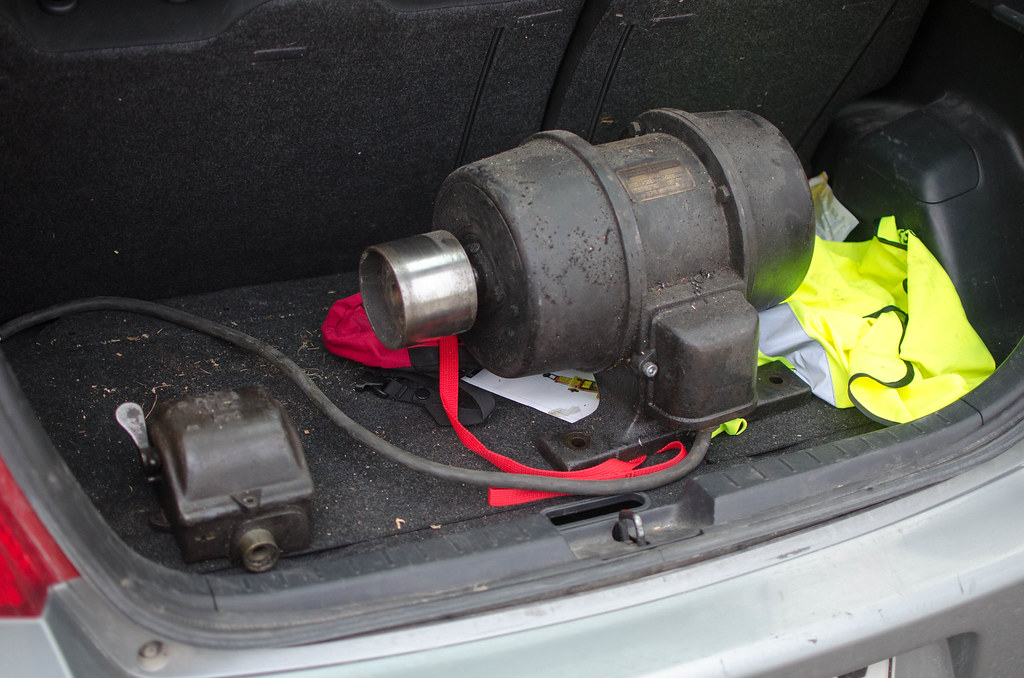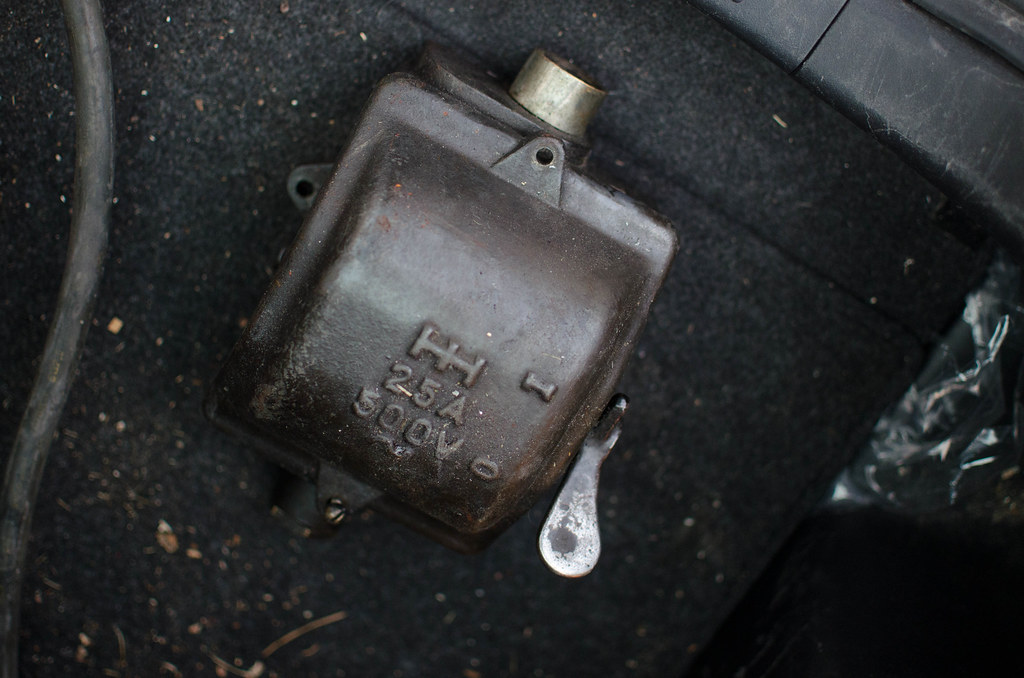|
dwoloz posted:My power company, PGE, is going to be installing service to my property for the first time. They tell me I can get a drop from their pole max of 150ft and they'll run 1/0 aluminum. What I don't understand is that they keep on telling me that this is 200A service. Per NEC table 310.15(B)(16) 1/0 alu is good for only 120A. What gives? 310(B)(15) is insulated conductors in conduit. Look at 1/0 in 310(B)(17). 1/0Al gives 205A @ 90C. Also, Power Company is their own jurisdiction, and they can write their own rules.
|
|
|
|

|
| # ? May 8, 2024 11:40 |
|
Had a funny one this morning (UK). Switched on the bathroom light, then the extractor fan, then the shower. The lights went out and the shower and fan switches turned off. Checked the breaker and the 'lights/smoke alarm' breaker had tripped. Flicked it back on, a spark shot out and it tripped out again. Switched it back on and all seems okay except none of the upstairs lights are working and the extractor fan is also out. The shower switches in both bathrooms are fine. The lights are on a separate circuit to the extractors and fans ( at least I think they are as they have separate breakers in the fuse box) so I'm puzzled as to why the fan failing or shorting has buggered all the lights. I've checked inside all the light sockets and shower/fan switches for loose wires etc. but no clues. Not sure what to check next?
|
|
|
|
I am trying to get some additional power to my garage for outlets and lighting. I've had two quotes done. The first guy recommended a 60 amp subpanel in the garage. From there run wire in conduit to the exterior lights, interior lights, and outlets. This guy opened the panel and checked the number of existing circuits and number of available tandem positions and said there is space. The second guy says that our 200 amp panel is full and he doesnt recommend a subpanel. Instead he would just run two two circuits to the garage and place a couple of existing circuits on tandem breakers. He thought putting in the subpanel would risk popping the main breaker. The prices from these two was very similar. Am I mistaken in believing that the sub-panel option is better? I guess I dont understand how there can be space for two new circuits but not enough space to put in the sub-panel.
|
|
|
|
monkeytennis posted:Had a funny one this morning (UK). Switched on the bathroom light, then the extractor fan, then the shower. The lights went out and the shower and fan switches turned off. "Extractor fan". I like that term. It makes my farts sound more noxious. Anyway, it sounds like you had a loose connection in one of your boxes on that circuit that tripped and currently won't turn on, then when you turned it back on, one of the connections burned enough to break the connection, only leaving part of the circuit energized. Figure out all the boxes that are currently off, then turn that circuit off, pull the devices out of those boxes, look for loose connections or wires burnt through and repair as necessary. Kastivich posted:I am trying to get some additional power to my garage for outlets and lighting. I've had two quotes done. The first guy recommended a 60 amp subpanel in the garage. From there run wire in conduit to the exterior lights, interior lights, and outlets. This guy opened the panel and checked the number of existing circuits and number of available tandem positions and said there is space. Subpanels have 2 advantages: running fewer cables to outlying areas (cheaper and easier), and reducing the walk back to the breaker if you happen to trip one at that outlying area. I think you're confusing breaker space and breaker loads. Just because you have or can free up space for more breakers in your panel doesn't mean that you can safely add more load to that panel. There are some calculations for this. That being said, big amperage garage subpanels are popular now due to chargers for hybrid cars. Those run up to 40A I believe, one per car bay. Then there's other garage big-draw tools you can have like welders, compressors, etc. kid sinister fucked around with this message at 18:03 on Aug 11, 2015 |
|
|
|
kid sinister posted:Subpanels have 2 advantages: running fewer cables to outlying areas (cheaper and easier), and reducing the walk back to the breaker if you happen to trip one at that outlying area. This makes sense, but if he says there is enough power to run a couple of 20 amp circuits to the garage, why not just run the subpanel?
|
|
|
|
RedReverend posted:Source: I'm a poco engineer. Since you dropped in and made the mistake of exposing your secret identity, I've got a minor issue that I haven't had the time/motivation to sort out: There's a short run for telecom service over the middle of my back yard that seems to date to very early in this house's lifetime -- at least before the fairly old carport was built, which seems like it would be a much more natural place to run the cable to where it enters the building. In fact, there are two cables: both identical, one of which was just cut at both ends for some reason and is kind of just dangling there. Instead of running about 35' across my back yard, and then another 50' along my eaves to the connection, I'd really love it if it ran the 10' between the lines and the edge of the carport, and then the much shorter distance to the service entrance (removing a bunch of dangling cables). 1) Is this a reasonable thing to ask a provider to do? I'm happy to pay a (non-ridiculous) service fee for it, especially since it would be more secure from downed trees/branches in addition to being much more aesthetically sound. 2) Who on earth would I talk to about it? I'm in Northern VA, so my telecom provider is (in this case) Verizon and Dominion Power owns the poles. I haven't bothered to contact either yet, but I am kind of dreading playing the "it's not our service, talk to the other guy" / "it's not our poles, talk to the other guy" game. 3) If this is reasonable and someone knows the right organization to talk to, how do I describe what I'd like to be done in a way that's clear to them so I don't have to explain it a half-dozen times? Is there a word for this type of request (aside from "some rear end in a top hat homeowner"  )? )?I can provide photos if you want to see exactly what I'm talking about.
|
|
|
|
Hubis posted:Since you dropped in and made the mistake of exposing your secret identity, I've got a minor issue that I haven't had the time/motivation to sort out: Contact Verizon and ask for them to reroute the service drop. They will charge but it shouldn't be too expensive, probably just a couple hours of labor along with a service charge. Usually the telecoms rent space on the poles and are allowed to work up to a certain height so I doubt it'll be an issue. Actually, I've been meaning to call and have my phone wire removed completely as I doubt I'll ever have a landline.
|
|
|
|
RedReverend posted:Contact Verizon and ask for them to reroute the service drop. They will charge but it shouldn't be too expensive, probably just a couple hours of labor along with a service charge. Awesome, thanks.
|
|
|
|
Kastivich posted:This makes sense, but if he says there is enough power to run a couple of 20 amp circuits to the garage, why not just run the subpanel? Define "a couple". There is a price point where running multiple cables for multiple small circuits from the main panel would actually be cheaper than installing a thicker cable and a subpanel.
|
|
|
|
kid sinister posted:Define "a couple". There is a price point where running multiple cables for multiple small circuits from the main panel would actually be cheaper than installing a thicker cable and a subpanel. Well the price between the two quotes was actually within $100 of each other (there were differences in prices on individual tasks but the overall total was very close). Given that the price is the same the sub-panel seems to be the better choice.
|
|
|
|
For $100 get the subpanel.
|
|
|
|
Got this motor, really old finnish 1.1kw 3ph motor. I think I would like to use it to build John Heisz' 2x72 belt grinder: The question I got is concerning this cool old breaker that came with it:  It's all metall, even the lever. As such I've been told by some people that it's hazardous, if something goes wrong with the wiring and grounding in particular, then I die. Another person told me if you ground it, and make sure the lever itself is grounded too, it fulfills the electrical code and should this be safe. And I have GFCI breakers for all my circuits so I think that should provide some additional protection. I dunno, I was thinking maybe there's some non-conductive powder coating or similar treatment I could give it to really make it safe, or am I overthinking things? I mean it's really cool I think, would be cool to start the motor with it.
|
|
|
|
His Divine Shadow posted:I dunno, I was thinking maybe there's some non-conductive powder coating or similar treatment I could give it to really make it safe, or am I overthinking things? I mean it's really cool I think, would be cool to start the motor with it. You're overthinking it, and so are the people you're talking to. Yes, if everything goes HORRIBLY WRONG, you will touch energized parts. However, you should wire the thing up so all metal bits [that shouldn't have power going through them] are solidly connected to ground, that way if something begins to go slightly wrong, then your GFCI and/or breaker trips.
|
|
|
|
Hopefully this is the right thread. I recently switched back to TWC for both cable and internet. Problem is, our signal was on the weak side, especially after all of the daisy chained splitters. I replaced all of the splitters with an active two way cable amplifier (which fixed every cable issue we had). The problem is, the amp is also a surge protector (up to 6kV, supposedly), and has a ground terminal. I have no idea where to connect the ground wire to. It came with a wall wart for power, except said wall wart uses coax for the power (and it's 2 prong, so no way is it handling grounding). The paper that came with it doesn't mention anything about actually hooking up a ground. This is the amp I picked up, and it's done an amazing job with boosting the signal quality - both down and upstream. Obviously, the outside coax is hooked up to a grounding block, which is connected to a ground rod next to our power meter. I'm just trying to make sure that #1, it's safe even in a nasty storm, and #2, it's code compliant. The coax is underground, if it matters (comes up about 5 ft on the garage wall before entering the house). semi-fake edit: there's a water heater nearby with a ~10-12 gauge bare copper ground wire connected to the cold water inlet (seems to go back to the panel, if I had to guess, but most of it is buried under plenty of blown-in insulation), and there's also a typical duplex outlet nearby that's powering the amp (this is all in the attic). randomidiot fucked around with this message at 09:31 on Aug 14, 2015 |
|
|
|
some texas redneck posted:
That can be used as the first point of entry into a residence, in which case you'd use the ground, but you're not and it's already grounded, so you're fine.
|
|
|
|
So our TV is giving me electrical shocks. I noticed it because the shielding on an HDMI cable from TV to computer was giving me a shock; it sparks when I touch it against the case of my computer. After a couple of hours annoying my girlfriend by pulling things out from the wall and turning off breakers, I've discovered:
The manual for the Bravia does mention things like "don't clean the screen without unplugging the TV or you might get an electrical shock" so this may not be a problem with the TV as such. I wouldn't be worrying about it, but I had to return my last graphics card for RMA as it was glitching, and I'm concerned that maybe I actually burnt something out on it by introducing voltage via the ground on the HDMI cable. I'd also quite like to not get random electrical shocks whenever I plug things in back there... I'm thinking the best option might be to connect something in the area to ground to try and dump the stray voltage so it's not going through me/my computer. We don't use a TV aerial so I could use that socket - is there such a thing as a grounding plug that goes into the mains from a TV aerial? I could make one up with aerial cable and a mains plug, but this feels somewhat shaky even if I don't connect to anything other than the earth pin. I could probably also just run cable from something on the TV to the nearby heating pipes. Alternatively something on the HDMI run (it goes via an unpowered switch then into my computer) to do the same thing. I'm in the UK if that happens to make any difference to my options. Any better suggestions? Am I worrying about nothing?
|
|
|
|
Unplug everything including cables from the tv (any hdmi, coax, cat5, everything, usb). I'm unfamiliar with UK plugs make sure it isn't a plastic cap over the ground plug. Plug the power supply in the wall but not the tv. Check voltage with dmm and for leakage around the psu. Then connect only the psu to the tv. Check for leakage. Power on tv check for leakage.
|
|
|
|
XmasGiftFromWife posted:Unplug everything including cables from the tv (any hdmi, coax, cat5, everything, usb). I'm unfamiliar with UK plugs make sure it isn't a plastic cap over the ground plug. Didn't think of that, thanks. But... everything unplugged, TV powered on - still leaks. TV in standby, no leak (same as it was). The power supply is an external transformer with no ground - two wires in at 240V AC, two wires out at 19.5V DC. The shroud on the barrel plug coming out of the transformer is at 0V with respect to true ground, though, so I don't think it's that. (And the centre pin is 19.5V as it should be).
|
|
|
|
I have an incredibly stupid question that comes more from my paranoia than anything else. I replaced a few 3-way light switches in the home. Pretty easy for the most part and everything seems to work great. On one of them, the common wire had a slightly wider loop to the end (the exposed part). It fits around the screw fine and is firmly in place, but the edges touch the plastic a little bit in that crevice under the screw. I'm assuming this is perfectly fine since plastic isn't going to conduct anything and it would be pretty difficult to avoid touching the plastic on every switch in your house without being anal with the wiring. But being new to electric stuff I just want to make sure I am not doing something dumb that will cause a problem. Also, do you recommend wrapping the switch up in electrical tape after? I read some conflicting opinions on it but the previous person did it here so I figured I'd just follow suit as there is no harm in it.
|
|
|
|
Hello again. Pardon my extreme ignorance but I need some advice. I am trying to etch some patterns in steel. I found an instrctables guide showing how to convert a DC transformer into an etcher that etches on DC and can switch over to mark on AC. I tried it out and it works but does not have a lot of power. The instructions suggested 5-12 volts at one amp. The best I could find was 9 volts at 850 mila amps. Someone told me they had a variable DC power supply. It runs 1-120 volts at 22 amps. This sounds like it is way too much power. But I realize that 1volt at 22 amps is only 22 watts. So my question is, would 1 volt at 22 amps be OK for etching, or would I be doing something very stupid and dangerous?
|
|
|
|
ArtistCeleste posted:Hello again. Pardon my extreme ignorance but I need some advice. I am trying to etch some patterns in steel. I found an instrctables guide showing how to convert a DC transformer into an etcher that etches on DC and can switch over to mark on AC. I tried it out and it works but does not have a lot of power. The instructions suggested 5-12 volts at one amp. The best I could find was 9 volts at 850 mila amps. You need enough voltage to overcome some chemistry. That DC power supply is capable of 22A max; does it have adjustable current as well? If not, get an old-fashioned light dimmer (not a solid-state) and wire that up in series.
|
|
|
|
Niwrad posted:I have an incredibly stupid question that comes more from my paranoia than anything else. As long as you've got everything tightened down properly, the little bit of extra length that was stripped won't matter. re: tape, it's not required, but if you're working in an older metal box where tolerances were tighter, it can be useful for piece of mind that nothing's touching.
|
|
|
|
What is the best way for me to determine the amp service to my house? I was hoping there'd be some sort of identifying marking on the meter or main breaker panel, but I'll be damned if I can find anything. Basically I want to install a main breaker, but don't know whether to purchase a 100 or 200 amp breaker for my panel. Here's a link to an album with pictures of my meter/panel. I'm sure there's supposed to be shutoff on there, but it's MIA. There is, however, a nice empty slot where one should be. http://imgur.com/a/huTro I know the meter box should have been locked, but the tamper tag was cut and the lock gone since before I bought the house last year. That's why I went ahead and opened it up, to see if the shutoff was inside the meter box or something like that. I'm assuming the "electric updated in 06" was all under the table, because a lot of what I've seen seems pretty shoddy, and it appears the lock was cut to pull the meter and install the new breaker panel. The copious use of electrical tape doesn't inspire confidence either. E: Added a picture of the lid on the breaker panel. The Mains Rating box is empty, where I'm presuming the amperage should be listed. (Also, just in defense of the crappy labeling, I'm going to print out labels and get everything properly mapped asap, just been scrawling notes and correcting as I go) Catatron Prime fucked around with this message at 17:43 on Aug 18, 2015 |
|
|
|
OSU_Matthew posted:What is the best way for me to determine the amp service to my house? I was hoping there'd be some sort of identifying marking on the meter or main breaker panel, but I'll be damned if I can find anything. The meter is rated for 200A (the 200CL designation on it), but the model on the load center cover is just for the cover itself. QO 40-space load centers come in both 125A and 200A variants, and there's nothing in your picture that will tell me either way, though that many circuits on a 100/125A service seems like stretching it. Your bill might say what kind of service you have.
|
|
|
|
Qwijib0 posted:The meter is rated for 200A (the 200CL designation on it), but the model on the load center cover is just for the cover itself. QO 40-space load centers come in both 125A and 200A variants, and there's nothing in your picture that will tell me either way, though that many circuits on a 100/125A service seems like stretching it. Your bill might say what kind of service you have. Thank you so much--I really appreciate it!! I'll check my bill/call AEP to find out for sure then. I just started looking into the process of getting inspections/permits, since I'm assuming I ought to get one for doing this kind of thing, and I'll call my local office to pester them since they'll have the answers, but in the meantime, am I as the current owner on the hook for any past indiscretions? Eg, is it possible that an inspector would fine me for the previous owners cutting the meter lock/tag (assuming it wasn't just left that way), or somehow condemn the breaker panel work that's already there if it wasn't properly permitted the first time around? Or would a permit/inspection be limited to the scope of the work performed, with the ability to ask the questions/opinions on other things while they're there? Or is this a YMMV kind of thing? Just don't want to get screwed by trying to do the right thing, and I've got no experience in this area...
|
|
|
|
OSU_Matthew posted:Thank you so much--I really appreciate it!! I'll check my bill/call AEP to find out for sure then. Well, the meter tag is something the power company would care about, but the level they care about it depends entirely on the company. If you called them and mentioned it looks like it'd been cut, and your billed usage looked normal my guess is they'd just send someone out with a new tag and that's about all that would happen. If you pull a permit to add a main breaker, and the rest of the box is questionable, then you will have to fix it before it passes. It's worth noting that if you currently don't have a main disconnect, and it would take more than 6 breakers to turn off all power to the house, then you're already out of compliance.
|
|
|
|
I dunno what the resi pros would suggest, but personally I'd replace that whole service entrance cable, get it protected in conduit, and replace the meterbase with a combination box (meterbase with attached load center with main breaker), with an actual service mast and new wire. Edit: and check out that subpanel they installed because clearly they had no problem installing fuckery.
|
|
|
|
angryrobots posted:I dunno what the resi pros would suggest, but personally I'd replace that whole service entrance cable, get it protected in conduit, and replace the meterbase with a combination box (meterbase with attached load center with main breaker), with an actual service mast and new wire. I agree with the conduit, but I'd just put a single main cutoff directly below the meter base. That doesn't require any Power Company nonsense. Pull your permit, pull the meter out, take the load-side lugs off, pull wire out, install conduit w/ new disconnect switch (main cutoff breaker), reattach load lugs, reinstall meter, call PoCo to install seal/inspector to do final check.
|
|
|
|
What size breaker would you put in it? I'm just curious, my suggestion is weighted by what I see done around here, most new and remodeled houses get a 200a service when they do it, and that looks like a 125a meterbase. I can't tell from the picture, but if it has cable out the top of the meterbase as well (not in conduit), would you leave that as well? Also, since your first means of disconnect is now outside, don't you need to bond there, and pull a ground inside, and make sure the neutral is not bonded inside the sub panel? angryrobots fucked around with this message at 19:07 on Aug 19, 2015 |
|
|
|
angryrobots posted:What size breaker would you put in it? I'm just curious, my suggestion is weighted by what I see done around here, most new and remodeled houses get a 200a service when they do it, and that looks like a 125a meterbase. I'd put whatever the power company said my service size is in a 200A frame. That way there's expansion available. Anything that's hot when the meter is removed is the power company's jurisdiction, and they can deal with it. I wouldn't touch it at all. Yes, you'd bond right there at the disconnect outside and pull the bonding lug off of that "main" panel.
|
|
|
|
angryrobots posted:I'd replace that whole service entrance cable, get it protected in conduit, and replace the meterbase with a combination box (meterbase with attached load center with main breaker), with an actual service mast and new wire. Qwijib0 posted:Well, the meter tag is something the power company would care about, but the level they care about it depends entirely on the company. If you called them and mentioned it looks like it'd been cut, and your billed usage looked normal my guess is they'd just send someone out with a new tag and that's about all that would happen. Thanks for pointing that out! That's a really great idea, I'll call the local inspector to clear up questions and see about getting permits and research out what I need to do to upgrade the service entrance. This is all stuff I want to learn about anyways, and I just found out that one of my relatives used to be an electrician, so I'll get his input/help too. My original scope was to add the main breaker, so I can start removing and replacing the old cloth/rubber covered, crumbling braided wire that constitutes everything past the first receptacle on every circuit I've dug into. I had originally shut one down one breaker to replace a run when I discovered that two different breakers were being run through the same work box in the basement, and the other circuit was still live. Just one of many examples of questionable things that keep cropping up as I go 
|
|
|
|
.
angryrobots fucked around with this message at 05:00 on Nov 8, 2017 |
|
|
|
Hi, I'm planning on selling my house in the next month, so I decided to update all the ugly almond light switches in my house to new, white ones: However, when I started tonight, the first switch already didn't match my expectations. For reference, my house was built in 1978 and I suspect this is all of the original wiring. I'm starting in 1 of the guest bedrooms (my 'office area'), and as it was the light switch controls just the ceiling light/fan fixture. However, when I pulled out the switch, I found this mess (I labeled them myself after the experiment below):  It's 3 black wires and 1 red wire (2 black wires 'backstabbed' into the back of the switch, and the other 2 wires attached to the screws on the side). My diagram:  I used an electrical meter to find the 1 black wire with power coming to it and labeled it. Then I tried connecting combinations of the Live wire with each of the other wires. The Results: Black Wire 1 & Live - the light/fan worked, but I lost power to one of the electrical outlets Black Wire 2 & Live - the electrical outlet is now tied to the light switch position, and the light/fan never works Red Wire & Live - nothing happens Of course, with all of the above, I end up with 2 extra wires just hanging out. So, my question, how would I be able to use my new light switch so that my electrical outlet always has power and the switch controls the light/fan? My initial theory is to somehow tie the Live Wire and the Electrical Outlet wire together, and then feed that into the switch along with the Ceiling Light wire, but that leaves the red wire unaccounted for and that worries me. In case it matters, here's a small picture of the room (I'm planning on replacing the ceiling fan with something less ugly as well):  Edit: Also, this is just a single-pole light switch, there's no other switch that controls anything in this room. When I Googled my problem, I kept getting results for 3-way switches, but I don't think that's what I need. Discospawn fucked around with this message at 05:16 on Aug 23, 2015 |
|
|
|
That looks like a regular switch-- the backstabs and the screw on the same side are electrically connected all the time, so as wired, the outlet always has power because it's in the backstab connected to the live screw. When you turn on the switch, power is delivered to the fan and "red". If you don't know what red does, and don't care, just cap it with a wire nut, then wire nut together live, outlet and a short pigtail wire that will go to the switch that will then only control the fan. edit: that Red probably goes to the ceiling box so you could have separate switches for the light and fan.
|
|
|
|
Copy that, it sounds like the old switch was just doing what I was already thinking about doing (tying the livewire to the outlet). Thanks! Edit: Hooked it up today and it works! Discospawn fucked around with this message at 23:20 on Aug 23, 2015 |
|
|
|
I replaced an outlet in my apartment (the building was built in 1998 I think), and it looks like there's no grounding wire. How bad is this?
|
|
|
|
Is it in a steel box that itself is grounded?
|
|
|
|
Safety Dance posted:I replaced an outlet in my apartment (the building was built in 1998 I think), and it looks like there's no grounding wire. How bad is this? I would guess about 3 deaths per year per 10.000 households because of that. So not that bad. (Number pulled out of my rear end) It's dangerous if you have an appliance with a (partly) metal casing and the phase making contact with it. This can happen if a cable inside isn't attached properly and makes contact with the casing or a cable rubbing on a sharp edge or just the insulation rotting off. This would mean the metal parts now have 110Volts on them (depending on where you are). If you then touch the metal parts and are grounded yourself (for example holding on to sink or in bad cases, just touching the floor with your feet), the current will go through you. And this "could" kill you. The chance to kill you is there, but it's very low afaik (I only have anecdotes about me surviving shocks, no hard data). It totally depends on the resistance between you and the ground and where the current goes through your body, many factors. If you don't have a toddler running around, just be aware that it could be potentially dangerous to touch metal parts of appliances that have a plug with a ground connector. And you should be good.
|
|
|
|
kid sinister posted:Is it in a steel box that itself is grounded? It may well be. Building code requires that all wires run through conduit. If the conduit itself is grounded and the junction box is metal, does that mean that there's a path to the ground through the screws that hold the outlet to the box?
|
|
|
|

|
| # ? May 8, 2024 11:40 |
|
Welp, my idiot buddy sprayed over the bare wires I had exposed in my bedroom when I disconnected the baseboard heaters and outlets on conduit to paint. I can pull them out enough to identify the original colors to match my diagrams, but I don't think I can pull them out enough to cut the painted sections off as there was not much slack to begin with. I'll try to strip the paint as best I can, but is the paint on wires a fire hazard or something that happens all the time? It's Sherwin Williams Superpaint which is an acrylic latex if that matters.
|
|
|





























